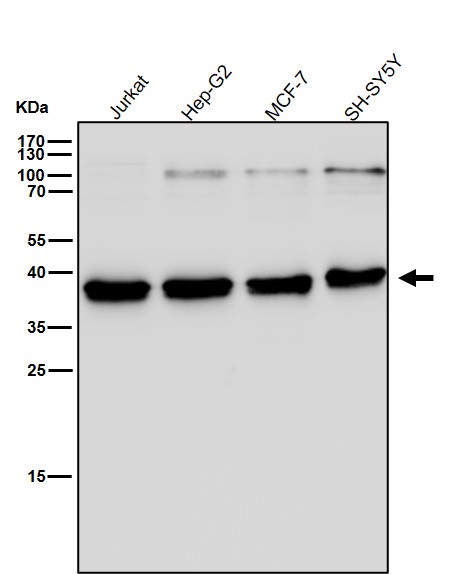


| WB | 咨询技术 | Human,Mouse,Rat |
| IF | 咨询技术 | Human,Mouse,Rat |
| IHC | 咨询技术 | Human,Mouse,Rat |
| ICC | 技术咨询 | Human,Mouse,Rat |
| FCM | 咨询技术 | Human,Mouse,Rat |
| Elisa | 咨询技术 | Human,Mouse,Rat |
| Aliases | 2F1 Ag; CLEC15A; KLRG1; MAFA 2F1; MAFA L; MAFA like; MAFAL;;KLRG1 |
| WB Predicted band size | Calculated MW: 22 kDa ; Observed MW: 38 kDa |
| Host/Isotype | Rabbit IgG |
| Antibody Type | Primary antibody |
| Storage | Store at 4°C short term. Aliquot and store at -20°C long term. Avoid freeze/thaw cycles. |
| Species Reactivity | Human,Mouse,Rat |
| Immunogen | A synthesized peptide derived from human KLRG1 |
| Formulation | Purified antibody in PBS with 0.05% sodium azide,0.05% BSA and 50% glycerol. |
+ +
以下是关于KLRG1抗体的3-4篇参考文献及其摘要内容:
1. **文献名称**: "KLRG1—A Marker for Cytotoxic Effectors in Human T Cells and NK Cells"
**作者**: Huntington, N.D., et al.
**摘要**: 该研究阐明了KLRG1作为人类T细胞和NK细胞终末分化效应细胞的表面标记,并验证了特异性抗体在流式分选中的应用。结果显示KLRG1+细胞具有更强的细胞毒活性,但增殖能力受限。
2. **文献名称**: "Expression of KLRG1 on Virus-Specific CD8+ T Cells Correlates with Memory Differentiation"
**作者**: Voehringer, D., et al.
**摘要**: 通过抗体验证,研究发现KLRG1在慢性病毒感染(如CMV)的抗原特异性CD8+ T细胞中高表达,与终末分化表型相关,提示其作为记忆T细胞亚群的标记物。
3. **文献名称**: "KLRG1+ NK Cells Exhibit Antitumor Activity in Chronic Lymphocytic Leukemia"
**作者**: Rückert, M., et al.
**摘要**: 利用KLRG1抗体阻断实验,研究发现KLRG1+ NK细胞通过抑制性受体通路调控对白血病细胞的杀伤功能,提示其在癌症免疫治疗中的潜在应用价值。
4. **文献名称**: "KLRG1 as a Prognostic Marker in Colorectal Cancer"
**作者**: Backx, E., et al.
**摘要**: 通过免疫组化分析肿瘤浸润淋巴细胞中的KLRG1表达,发现高表达患者总生存期更长,表明KLRG1抗体检测可用于评估结直肠癌患者的预后。
这些文献涵盖了KLRG1抗体在基础免疫学、病毒感染及肿瘤研究中的应用,涉及功能验证、表型分析和临床预后评估。
**Background of KLRG1 Antibody**
KLRG1 (Killer cell Lectin-like Receptor G1) is a transmembrane protein belonging to the C-type lectin receptor family, primarily expressed on natural killer (NK) cells and subsets of T cells, particularly effector memory CD8⁺ T cells. It functions as an inhibitory receptor, binding to cadherin family ligands (e.g., E-cadherin) to regulate immune cell activity. KLRG1 engagement suppresses lymphocyte activation, playing a role in immune tolerance and homeostasis.
KLRG1 antibodies are tools used to detect and study this receptor in research. They enable the identification of KLRG1⁺ cell populations via flow cytometry, immunohistochemistry, or functional assays. These antibodies are critical in exploring immune cell differentiation, exhaustion, and senescence, as KLRG1 expression often correlates with terminal differentiation in T cells and reduced proliferative capacity.
In disease contexts, KLRG1 is studied in infections, cancer, and autoimmunity. For example, elevated KLRG1 on T cells is linked to chronic viral infections and tumor microenvironments, marking exhausted or aged immune cells. Antibodies targeting KLRG1 also aid in evaluating immunotherapies, such as checkpoint inhibitors, by monitoring changes in inhibitory receptor expression. Overall, KLRG1 antibodies are vital for dissecting immune regulation mechanisms and developing therapeutic strategies targeting inhibitory pathways.
×